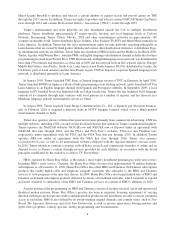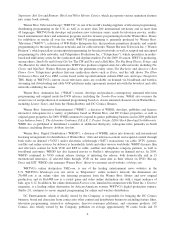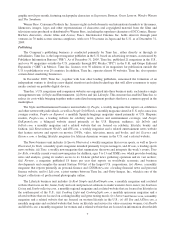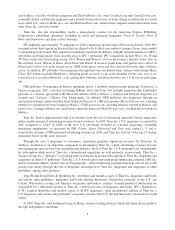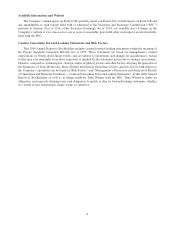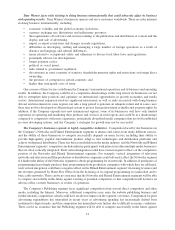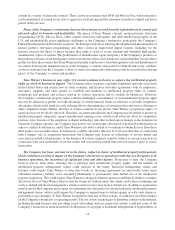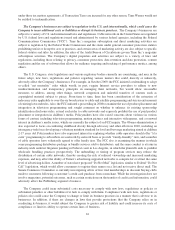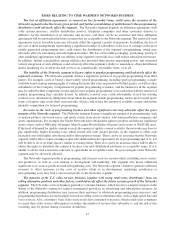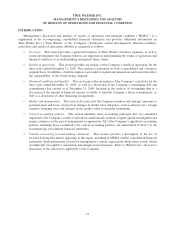Time Magazine 2009 Annual Report Download - page 23
Download and view the complete annual report
Please find page 23 of the 2009 Time Magazine annual report below. You can navigate through the pages in the report by either clicking on the pages listed below, or by using the keyword search tool below to find specific information within the annual report.affect the segment’s circulation revenues and also adversely affect its advertising revenues. Further, the Publishing
and Networks segments have taken various steps to diversify the means by which they distribute content and
generate advertising revenues, including increasing investments in Internet properties, which may not be sufficient
to offset revenue losses resulting from a continued shift in advertising dollars over the long term from traditional
media to digital media. In addition, this trend also could have an indirect negative impact on the licensing revenues
generated by the Filmed Entertainment segment and the revenues generated by Home Box Office from the licensing
of its original programming in syndication and to basic cable networks.
The Company has been, and may continue to be, adversely affected by weak economic and market
conditions. The Company’s businesses have been, and in the future will continue to be affected by economic
and market conditions, including factors such as interest rates, the rate of unemployment, the level of consumer
confidence and changes in consumer spending habits. Because many of the Company’s products and services are
largely discretionary items, the deterioration of these conditions could diminish demand for the Company’s
products and services. Such a decline could also increase the Company’s cost to provide such products and services.
In addition, expenditures by advertisers tend to be cyclical, reflecting general economic conditions, and therefore,
the deterioration of these conditions could adversely affect the Company’s revenues since the Company’s Networks
and Publishing segments derive a substantial portion of their revenues from the sale of advertising. Declines in
consumer spending due to weak economic conditions could also indirectly impact the Company’s advertising
revenues by causing downward pricing pressure on advertising because advertisers may not perceive as much value
from advertising if consumers are purchasing fewer of their products or services. Advertising expenditures also
could be negatively affected by other factors, such as shifting societal norms, pressure from public interest groups,
changes in laws and regulations and other social, political and technological developments. Disasters, acts of
terrorism, hostilities, global health concerns or pandemics also could lead to a reduction in advertising expenditures
as a result of uninterrupted news coverage and economic uncertainty. Advertising expenditures by companies in
certain sectors of the economy, including food and beverage, apparel, fashion and retail, pharmaceuticals and
medical, motion picture, automotive, financial/business services and insurance, toiletries and cosmetics, and
telecommunications, represent a significant portion of the Company’s advertising revenues, and any economic,
political, social or technological change resulting in a significant reduction in the advertising spending of these
sectors could further adversely affect the Company’s advertising revenues or its ability to maintain or increase such
revenues.
Declines in the global economy contributed to reduced advertising expenditures in 2008 and 2009, and, if
economic conditions do not improve, advertising expenditures could decline or remain at reduced levels. There is
also a risk that print advertising may not rebound when economic conditions improve, or it may take several years
for such a rebound to occur.
The Company also faces risks associated with the impact of economic and market conditions on third parties,
such as suppliers, retailers, film co-financing partners, insurers, lenders and other sources of financing and other
parties with which it does business. If these parties file for protection under bankruptcy laws or otherwise
experience negative effects on their businesses due to the market and economic conditions, it could negatively affect
the Company’s business or operating results.
Time Warner is exposed to risks associated with disruption in the financial markets. U.S. and global credit
and equity markets experienced significant disruption beginning in late 2008, making it difficult for many
businesses to obtain financing on acceptable terms. In addition, equity markets experienced wide fluctuations
in value. The Company is exposed to risks associated with disruptions in the financial markets, which can make it
more difficult and more expensive to obtain financing. In addition, disruptions in the financial markets can
adversely affect the Company’s lenders, insurers, customers and counterparties, including vendors, retailers and
film co-financing partners. For instance, the inability of the Company’s counterparties to obtain financing on
acceptable terms could impair their ability to perform under their agreements with the Company and lead to various
negative effects on the Company, including fewer outlets for retail sales, business disruption, decreased revenues,
increases in bad debt write-offs and, in the case of film co-financing partners, greater risk with respect to the
performance of the Company’s films.
11





